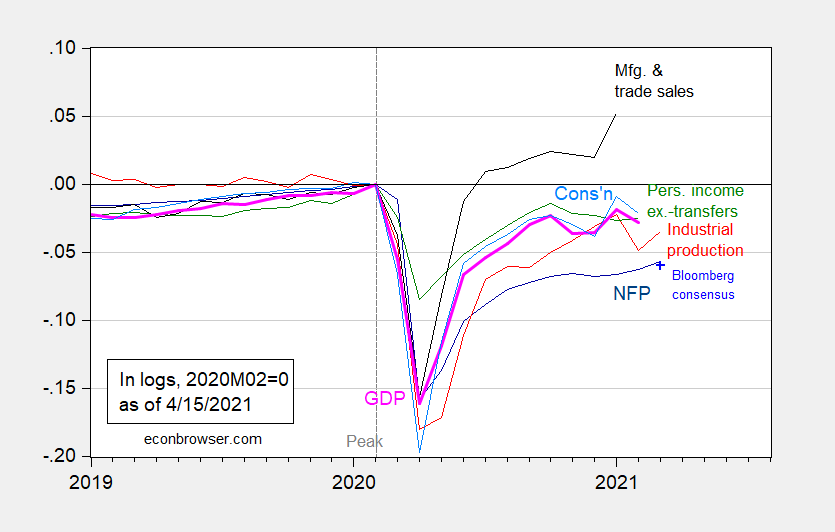Retail sales jumped 9.8% m/m, exceed Bloomberg consensus of 5.9%. Sales ex-food services rose 9.4% in nominal terms, 8.7% if deflated by the CPI-all.
Business Cycle Indicators as of Mid-April
Industrial production figures were released today, showing a rebound in March. In the context of key macro indicators followed by the NBER Business Cycle Dating Committee:
Figure 1: Nonfarm payroll employment from March release (dark blue), Bloomberg consensus as of 4/1 for March nonfarm payroll employment (light blue +), industrial production (red), personal income excluding transfers in Ch.2012$ (green), manufacturing and trade sales in Ch.2012$ (black), consumption in Ch.2012$ (light blue), and monthly GDP in Ch.2012$ (pink), all log normalized to 2020M02=0. Source: BLS, Federal Reserve, BEA, via FRED, IHS Markit (nee Macroeconomic Advisers) (4/1/2021 release), NBER, and author’s calculations.
Industrial production was whipsawed by weather in February, so it makes sense to look at manufacturing production as well. Seasonally adjusted industrial production rose 1.4% vs. 2.8% for manufacturing production (18.7% vs. 39.1% annualized). Industrial production is 3.4% below levels at NBER peak (2020M02), while manufacturing is 1.7% below. Incidentally, neither has re-attained the local maxima in January 2021.
Atlanta Fed GDPNow (4/15) is for 8.3% in Q1; IHS Markit nowcast (4/15) is 6.0% (both figures SAAR).
Wisconsin Employment: Employment Drop Revised Away
Wisconsin nonfarm payroll employment has stabilized at a level down 4.9% relative to NBER peak in 2020M02, vs. 5.5% for the nation overall (according to figures released by DWD today). In addition, the downward decline in February of 1.9% (annualized) has been largely revised away — it’s now 0.3% decline (annualized).
CPI Surprise
The CPI came in slightly above Bloomberg consensus (2.6% vs 2.5%), and above the WSJ April survey consensus (shown below).
The WSJ April Survey: Accelerating Growth Prospects
The survey results are out, and once again, the outlook improves.
When (US) Corporate Tax Rate Reductions Last Bloomed
Under the Tax Cuts and Jobs Act, no enormous surge in capital investment appeared, above and beyond what could be explained by aggregate demand changes. From the conclusion to U.S. Investment Since the Tax Cuts and Jobs Act of 2017, by Emanuel Kopp, Daniel Leigh, Susanna Mursula, and Suchanan Tambunlertchai.
The Trade Balance: Macro Dominates Tariffs
Like I said four years ago. By Trump’s own criterion, the trade war was lost. My view – that was a stupid criterion in any case.
The Market’s Expectations of Inflation and Real Rates over the Next Five Years
As of today, the five year constant maturity Treasury yield has stabilized for the last month at about 0.9%. The inflation breakeven implied by the spread between Treasurys and TIPS has plateaued at 2.52%. After accounting for the estimated term premium and liquidity premium, the implied inflation rate is 1.90% .
“Re-examining the Effects of Trading with China on Local Labor Markets: A Supply Chain Perspective”
From the paper by Zhi Wang, Shang-Jin Wei, Xinding Yu & Kunfu Zhu:
The United States imports intermediate inputs from China, helping downstream US firms to expand employment. Using a cross-regional reduced-form specification but differing from the existing literature, this paper (a) incorporates a supply chain perspective, (b) uses intermediate input imports rather than total imports in computing the downstream exposure, and (c) uses exporter-specific information to allocate imported inputs across US sectors. We find robust evidence that the total impact of trading with China is a positive boost to local employment and real wages. The most important factor is employment stimulation outside the manufacturing sector through the downstream channel. This overturns the received wisdom from the reduced-form literature and provides statistical support for a key mechanism hypothesized in general equilibrium spatial models.
Ungated version here. This is a slightly older paper (2018). A paper with related findings by Feenstra and Sasahara (2018) here, while ungated working paper version is here.
This is a reminder that import competition has direct impacts, but international trade allows firms access to lower cost inputs, and benefiting from comparative advantage. Separate from the question of net benefits is whether costs imposed on those negatively impacted outweigh those who gain, either in dollar or “util” terms.
Infrastructure Investment and Taxes
I talked about infrastructure investment and taxes on WPR yesterday. Will higher corporate tax rates and closing of loopholes in the taxation of corporations raise prices of goods produced? Given what happened in the wake of the 2017 reduction in corporate tax rates (i.e., lots of stock buybacks, not much higher investment), I think a resulting price increase not likely. On the other hand, the infrastructure spending could have an impact on productivity and hence prices.
